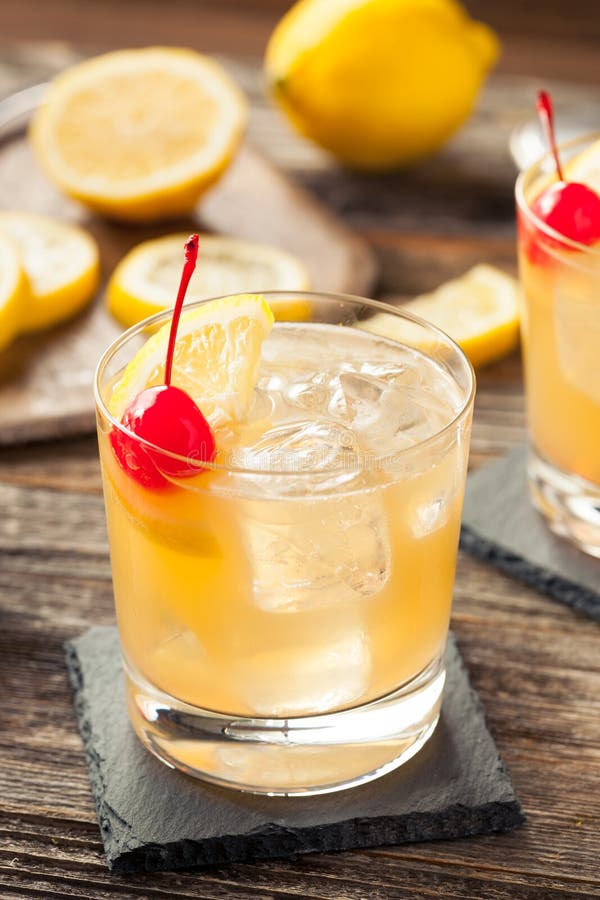

Adding an egg to a cocktail makes some people nervous, as it should there is a chance you are going to contract salmonella and become ill. Dale DeGroff’s The Essential Cocktail includes egg white as an option. Gary Regan’s Joy of Mixology does not include an egg. It went down a little smoother and looked a little better in the glass with the egg in it. The egg was later added as a creamy, frothy element to the cocktail. Jerry Thomas ultimately refined and published this imbibement, codifying the sour into black and white.Īnd what of that original recipe? Here is it, from the book: Gin and Brandy were also substituted in by the English, but the Americans were more fond of the native (and generally easier to obtain) whiskey. The sailors then brought this concept to shore and eventually the basics of the sour cocktail were refined to what we know it as. Hence, we have a very early version of the Sour.
#Whiskey sour cocktail full
To prevent a ship full of intoxicated shipmates, the liquor, usually rum once it was discovered, was watered down and lemon or lime juice was added to mask the flavor of the rum. Sailors had a ration of various things, like limes and lemons to prevent scurvy, and liquor for something safe to drink.
#Whiskey sour cocktail professional
Professional sailors suffered from scurvy and other malnutrition and sea-sicknesses, up until a bartender’s hero named Vice Admiral Edward Vernon of England began mixing a few ingredients together to serve to his crew. Food and water will spoil over a multi-month trip, and water wasn’t exactly safe. But sea travel, especially from Europe to North America, was not nearly as simple. You could stop off and resupply as needed or just go hunting and foraging. In those days, travel seemed to take forever, and up to the 20th century, refrigeration was lacking and the concept of germs was largely unknown. Long journeys over land weren’t terrible. However, the basic recipe was known for over a century prior. The recipe itself was first written down in the 1862 book The Bartender's Guide by Jerry Thomas. Gum (simple) syrup was later substituted for the sugar and water in some recipes, which is easier to blend into the cocktail. The citrus should be just present enough to balance out the sweetness of the sugar. The sugar needs the juice and water or soda to help dissolve the sugar. The base spirit is always the dominant flavor. The proportions are a bit off, but you get the idea. It has the elements of “ one sour, two sweet, three strong, four weak” that a classic punch has, but in an individual serving size. There are some historians that believe the sour category is a scaled down version of the basic punch. There is a base spirit, water, sugar, and a citrus element, usually lemon. It's as simple as you can get and still be called a cocktail. Daiquiris, Margaritas, Old Fashioneds, Gin and Tonics, are all starting to find their way back onto the menus of great cocktail establishments.Īnother cocktail that is starting to see the light of day is one that has used the simplest of building material, and enjoyed widespread popularity in the United States even before it was written down - the Whiskey Sour. They are enjoyable and well known from a customer standpoint, and easy to assemble from behind the bar.

There is something special about the simple cocktails. There has been a movement back to the basic blocks when it comes to cocktails. Food and drink are not immune to this arc. They get tired of all the whirling gizmos and extreme iterations and just want something simple that works. The product becomes so complex that the people buying the product yearn for something simpler. The original product begins to get more and more complex as competitors try to outdo each other with the most extreme versions they can find. Some of them catch on, some of them are mercifully discarded. More and more people begin to work with this new trend, everyone adding their own twist or adaptation. People use what they can find, adding new ingredients or processes as they become available. There is a grand pendulum that swings back and forth in trends.


 0 kommentar(er)
0 kommentar(er)
